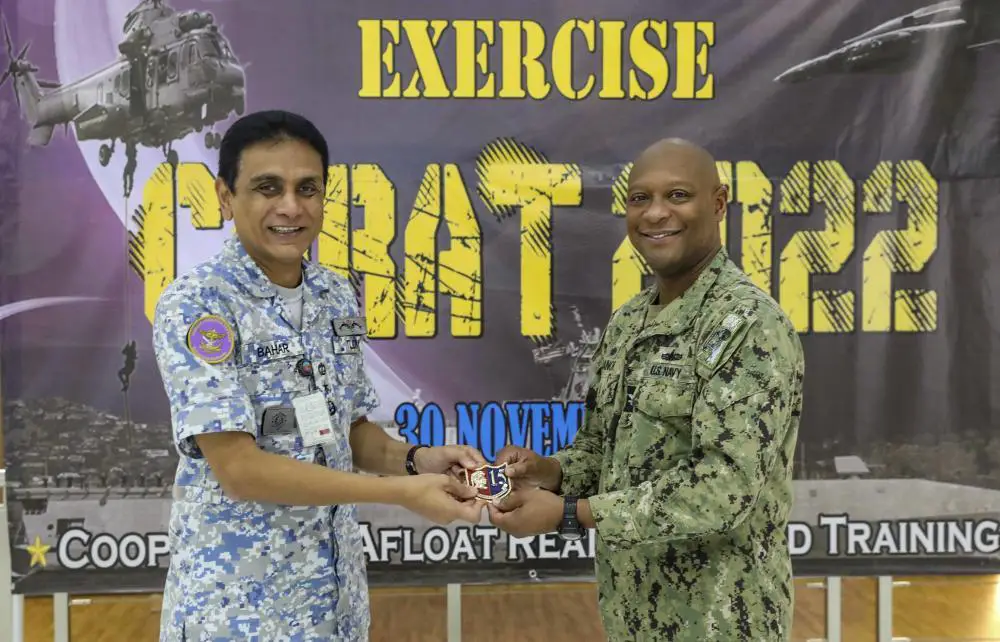Military personnel from Malaysia and the U.S. Naval forces conduct Cooperation Afloat Readiness and Training (CARAT) Malaysia 2022, Nov. 18-30. CARAT Malaysia 2022 highlights the 28th anniversary of CARAT among Allies and partners. CARAT demonstrates the U.S. Navy’s long-term commitment to strengthened relationships throughout South and Southeast Asia, and highlights U.S. commitment to key Association of Southeast Asian Nations (ASEAN) partners. Representing the U.S. Navy are the Independence-variant littoral combat ship USS Charleston (LCS 18), a P-8A maritime patrol and reconnaissance aircraft, staff from Commander, Task Force (CTF) 71, CTF 72, CTF 73, CTF 75, CTF 76, and U.S. 7th Fleet Band. These units will integrate with 1st Marine Expeditionary Force, 11th Marine Expeditionary Unit, and the Royal Malaysian Navy.
“Thank you to the Royal Malaysian Navy’s hospitality and personnel who planned, coordinated and contributed to the CARAT Malaysia 2022. Training and continued lessons learned developed during CARAT Malaysia provide maximum readiness and skills to respond to multi-national responses to natural, man-made disasters, and other crises in the future. We value our long-lasting relationship with the Royal Malaysian Navy, strengthened by routine participation in bilateral and multilateral exercises that focus on shared security priorities towards regional security, stability, and prosperity of the Indo-Pacific region,” said Capt. Walter Mainor, commodore, commander, Task Force 71/Destroyer Squadron 15.
“Charleston is eager to work side by side with our gracious Royal Malaysian Navy hosts to conduct operations at sea,” said Cmdr. Clay Beas, commanding officer of Charleston. “CARAT Malaysia is an excellent opportunity for our navies to learn best practices from each other and to focus on our shared belief that freedom of the seas is in the best interest of our nations.”
CARAT Malaysia features anti-submarine, air and surface warfare training, coupled with medical, dental, antiterrorism defensive measures and additional events to demonstrate interoperability.
Charleston, part of Destroyer Squadron (DESRON) 7, is on a rotational deployment, operating in the U.S. 7th Fleet area of operations to enhance interoperability with Allies and partners and serve as a ready-response force in support of a free and open Indo-Pacific region. As the U.S. Navy’s forward-deployed destroyer squadron in Southeast Asia, DESRON 7 serves as the primary tactical and operational commander of littoral combat ships rotationally deployed to Singapore, functions as Expeditionary Strike Group (ESG) 7’s Sea Combat Commander, and builds partnerships through training exercises and military-to-military engagements.
Under Commander, U.S. Pacific Fleet, the U.S. Seventh Fleet (U.S. 7th Fleet ) is a numbered fleet of the United States Navy. It is headquartered at U.S. Fleet Activities Yokosuka, in Yokosuka, Kanagawa Prefecture, Japan. It is part of the United States Pacific Fleet. At present, it is the largest of the forward-deployed U.S. fleets, with 50 to 70 ships, 150 aircraft and 27,000 Sailors and Marines. It would take three to five times the number of rotationally-based ships in the U.S. to equal the same presence and crisis response capability as these 18 forward deployed ships. On any given day, about 50% of Seventh Fleet forces are deployed at sea throughout the area of responsibility. Its principal responsibilities are to provide joint command in natural disaster or military operations and operational command of all US naval forces in the region.














